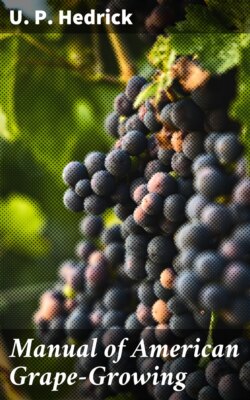Читать книгу Manual of American Grape-Growing - U. P. Hedrick - Страница 79
На сайте Литреса книга снята с продажи.
Influence of stocks on American grapes.
ОглавлениеNo doubt American species of grapes may be as profoundly modified by stocks as the European species, but there is but little evidence on this phase of grape-growing to be drawn from the experience of vineyardists. One rather conclusive experiment, however, shows that American grapes may be improved by growing them on stocks which give them better adaptations to their environment. The experiment was tried in the Chautauqua grape-belt in western New York by the New York Agricultural Experiment Station. The test was carried on for eleven years, during which time many interesting possibilities in grafting grapes in this region came to light. It was proved that the stock materially affects the vigor and productiveness of the vine and the quality of the grapes. The following brief account is taken from Bulletin No. 355 of the New York Station:
In this experiment a number of varieties were grafted on St. George, Riparia Gloire and Clevener stocks, and a fourth group on their own roots. The varieties grafted were: Agawam, Barry, Brighton, Brilliant, Campbell Early, Catawba, Concord, Delaware, Goff, Herbert, Iona, Jefferson, Lindley, Mills, Niagara, Regal, Vergennes, Winchell and Worden. The planting plan and all of the vineyard operations were those common in commercial vineyards.
Yearly accounts of the vineyard show that the vines passed through many vicissitudes. The experiment was started in 1902 when St. George and Riparia Gloire stocks from California were set and grafted in the field. Many of these died the first year. The winter of 1903–04 was unusually severe, and many more vines were either killed or so severely injured that they died during the next two years. The vines on St. George, a very deep-rooting grape, withstood the cold best. Fidia, the grape root-worm, was found in the vineyards early in the life of the vines and did much damage in some years. In the years of 1907 and 1909 the crops were ruined by hail.
But despite these serious setbacks it was evident throughout the experiment that the grafted grapes made better vines and were more productive than those on their own roots. As an example of the differences in yield, a summary of the data for 1911 may be given. In this year, an average of all the varieties on own roots yielded at the rate of 4.39 tons to the acre; on St. George, 5.36 tons; on Gloire, 5.32 tons; on Clevener, 5.62 tons. The crops on the grafted vines were increased through the setting of more bunches and the development of larger bunches and berries.
The grapes on the vines grafted on Gloire and Clevener ripened a few days earlier than those on their own roots, while with St. George a few varieties were retarded in ripening. Changing the time of maturity may be very important in grape regions where there is danger of early frost to late-ripening sorts, and where it is often desirable to retard the harvest time of early grapes.
In the behavior of the vines, the results correspond closely with those given for yields. In the growth ratings of varieties on different stocks, the varieties on their own roots were rated in vigor at 40; on St. George, at 63.2; on Gloire, at 65.2; on Clevener, at 67.9. There is no way of deciding how much the thrift of the vines depends on adaptability to soil, and how much on other factors. Since all of the varieties were more productive and vigorous on grafted vines than on their own roots it may be said that a high degree of congeniality exists between the stocks and varieties under test.
The experiment suggests that it would be profitable to grow fancy grapes of American species on grafted vines, and that it is well within the bounds of possibility that main-crop grapes can be grafted profitably. In the general tuning-up of agriculture now in progress, it may be expected that soon American as well as European varieties of grapes will be grown under some conditions and for some purposes on roots other than their own.
